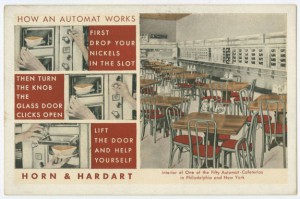
Automats
Beloved by generations of diners and immortalized in art, song, cinema, and poetic verse, Automats, also known as “automatics” or “waiterless restaurants,” were popular manifestations of an early-twentieth century modernizing ...
Stephen Nepa teaches history at Temple University and Rowan University. He is the author of “The New Urban Dining Room: Sidewalk Cafes in Postindustrial Philadelphia,” Buildings & Landscapes: Journal of the Vernacular Architecture Forum (Fall 2011), contributing author to A Green Country Towne: Art, History, and Ecology in Philadelphia (Penn State University Press, due 2014), and has written for Planning Perspectives, Essays in History, and Hospitality and Society. He received his M.A from the University of Nevada, Las Vegas and his Ph.D. from Temple University.

Beloved by generations of diners and immortalized in art, song, cinema, and poetic verse, Automats, also known as “automatics” or “waiterless restaurants,” were popular manifestations of an early-twentieth century modernizing ...
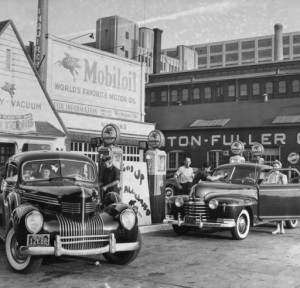
Since appearing in the 1890s, automobiles have in many ways shaped Greater Philadelphia’s history and geography. Initially a luxury item and later available on a massive scale, cars, while enhancing mobility, required billions of dollars in infrastructure, reordered the landscape of every town and city, and made indelible marks on the region’s architecture, culture, and ...
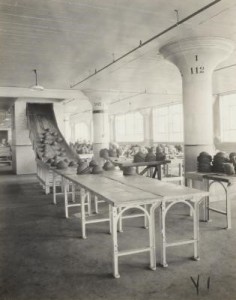
Once a mainstay of Greater Philadelphia’s industrial might and a reflection of the socioeconomic transformations of the twentieth and early twenty-first centuries, the manufacturing of automobiles and related components provided mobility for millions, jobs for many thousands, and lifeblood for towns and cities. First appearing in the 1900s, flourishing during the interwar and postwar periods, ...
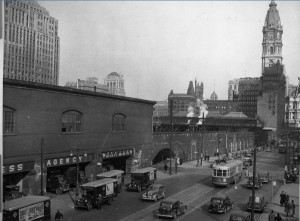
The Better Philadelphia Exhibition, which ran from September 8 to October 15, 1947, at Gimbels department store in Center City, showcased new ideas for revitalizing Philadelphia after decades of depression and war. Conceived by young architects and planners and funded by prominent citizens, the exhibition introduced more than 350,000 people in the metropolitan area, free of charge, to a vision of ...
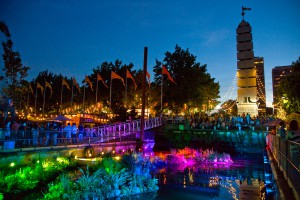
First designated by the U.S. Environmental Protection Agency (EPA) in 1995, the polluted tracts of land known as “brownfields” resulted from Greater Philadelphia’s industrial heritage. For more than a century, manufacturers generated vast amounts of waste and runoff. After industry declined between the 1950s and the 1980s, acres of abandoned structures and soiled land remained. Hundreds ...
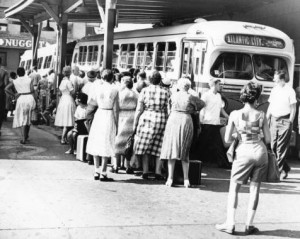
Beginning in the 1920s, the Philadelphia region’s independent transit companies added motorized buses (autobuses) to their networks. Superior in comfort to the horse-drawn omnibuses of the nineteenth century and with more range and versatility than electric trolleys, autobuses offered passengers easier means to traverse the metropolitan ...
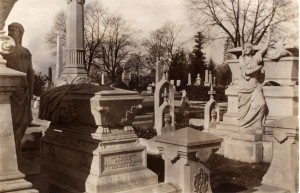
Cemeteries have been integral features of the Philadelphia-area landscape since the earliest European settlements of the mid-1600s. Over the centuries the region’s cemeteries matured from small, private grave sites, potter’s fields, and church burial yards to rural cemeteries, national cemeteries, and memorial parks. From the colonial period to the present, cemeteries reflected the area’s ...
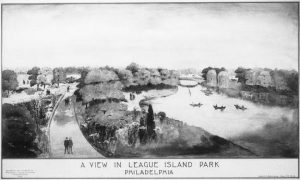
Grounded in landscape and European architecture and shaped by the politics of the Progressive Era, the City Beautiful Movement emerged in reaction to the physical decay and social congestion that burdened America’s industrial centers at the turn of the twentieth century. Considered the “mother” of urban planning, its promoters and practitioners sought to reorder the ...
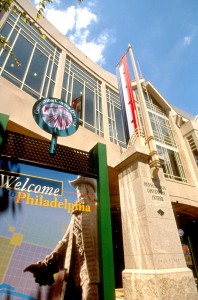
Philadelphia-area residents and visitors have required places for large assemblies since the colonial era, and a variety of temporary and permanent facilities served this purpose in the eighteenth and nineteenth centuries. Modern, multipurpose convention centers appeared in the late 1920s and have since grown in size and scope. By the early twenty-first century, many of the region’s cities, ...
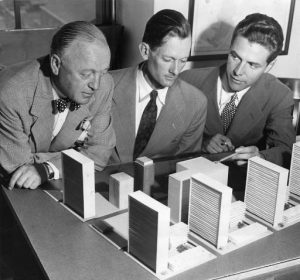
Published in 1967, Design of Cities assessed urban development from the ancient through the modern periods while highlighting many redevelopment projects in postwar Philadelphia. Written by urban planner Edmund Bacon (1910-2005) and replete with photographs, sketches, maps, and his insights, the book appeared during a time when urban renewal, historic preservation battles, racial tensions, and ...
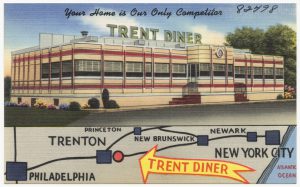
With its origins in late-nineteenth-century street vending and transient “quick lunch” operations such as horse-drawn food carts, the diner emerged as one of the most popular and successful restaurant genres in the United States. Although diners entered a period of protracted decline after World War II with the arrival of fast food restaurants, changing consumer tastes, and patterns of ...
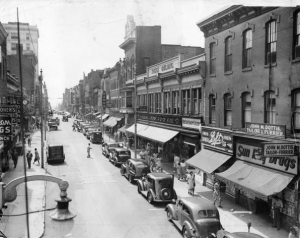
Edge cities, as they came to be called, emerged on the peripheries of older urban centers in the last part of the twentieth century. As defined by journalist Joel Garreau (b. 1948), they contained at least five million square feet of leasable office space, 600,000 (or more) square feet of leasable retail space, “more jobs ...
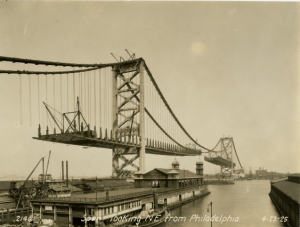
Long before bridges, trestles, and elevated expressways, the people and products of Greater Philadelphia required a network of ferries to traverse the region’s numerous waterways. Once ubiquitous on the area’s rivers, ferries were economic necessities that were phased out over time as industry changed and transportation ...

Market Street, one of Philadelphia’s primary east-west thoroughfares, originated in the 1682 city plan devised by William Penn (1644-1718) and Thomas Holme (1624-95) as High Street, one hundred feet wide and located at the longitudinal center of the city. Penn’s knowledge of plague and a devastating conflagration in 1660s London prompted the width of the ...
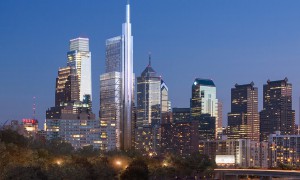
Greater Philadelphia’s office buildings reflect the aspirations of individuals, companies, and municipalities. Once clustered in cities and later spreading to suburbs throughout the metropolitan area, office buildings have mirrored changing architectural styles and economic patterns. While many celebrated office buildings have been demolished, others (new, restored, or adapted) stand as ...
The Philadelphia Transportation Company (PTC) strike, a five-day stoppage of the city’s mass transit system during World War II, resulted from longstanding racial animosities. Preceded by years of protest and ending only after the dispatching of federal troops, the strike exposed the dangers of workplace discrimination while threatening the material output of the nation’s third-largest war ...
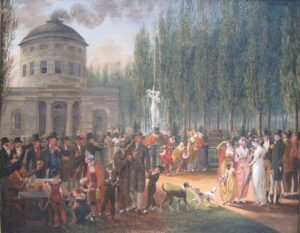
In its various forms, pollution immeasurably shaped the history and geography of greater Philadelphia. For nearly four centuries, contamination of the region’s air, land, and water reflected the civic and economic ambitions of people, businesses, and communities. Yet such contamination also compelled individuals, groups, and elected officials to address environmental and public health concerns ...
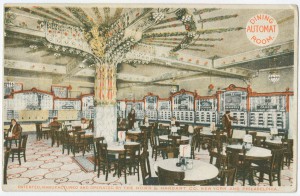
From colonial-era taverns to the celebrity chef establishments of the early twenty-first century, Greater Philadelphia’s restaurants illuminated the region’s socioeconomic, cultural, and culinary trends while also providing sustenance for millions, employing thousands, and in some cases emerging as historic and nostalgic ...
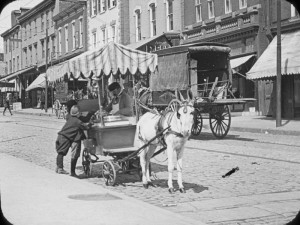
From the colonial period to the present, street vendors (or “hucksters”) have been integral yet contentious features of Greater Philadelphia’s economic landscape. Providing massive numbers of customers with food, clothing, and other goods while allowing many working people an occupational foothold in the region, vending also sparked controversies regarding taxes, regulation, public ...
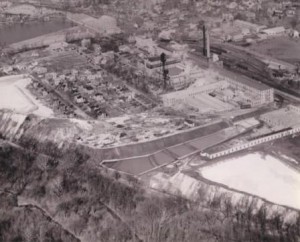
As a region with a complex industrial history that generated numerous chemical, industrial, and landfill operations, by the late twentieth century Greater Philadelphia held some of the nation’s highest concentrations of environmentally hazardous “Superfund” sites. Named for the federal Comprehensive Environmental Response, Compensation, and Liability Act of 1980 (CERCLA), also known as ...

Taverns in and around Philadelphia have been vital institutions, offering respite, nourishment, and camaraderie to travelers and patrons. Over time, attitudes and laws regarding the consumption of alcohol altered the character of the tavern and gave rise to modern hotels, restaurants, and ...
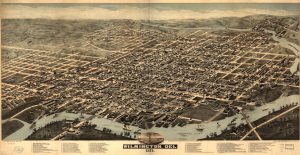
Located thirty miles southwest of Philadelphia, Wilmington is Delaware’s largest city and the New Castle County seat. It originated as a colonial trading area and ferry crossing and later became one of the country’s most vital industrial and chemical-producing centers. With the decline of manufacturing near the close of the twentieth century, the city emerged ...
Connecting the Past with the Present, Building Community, Creating a Legacy